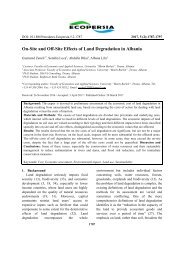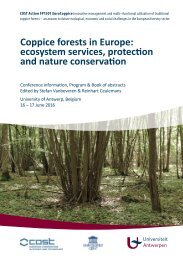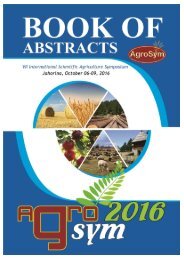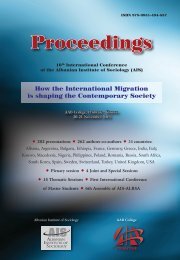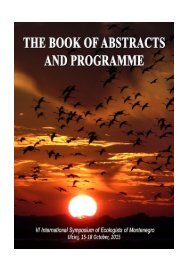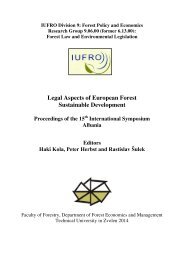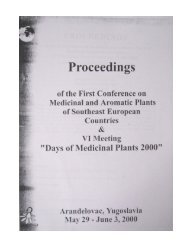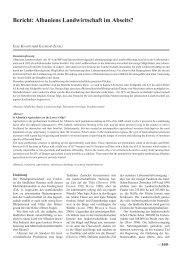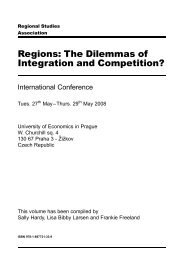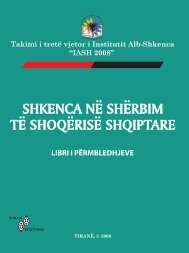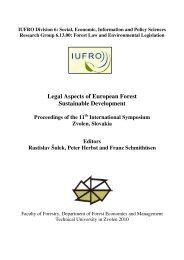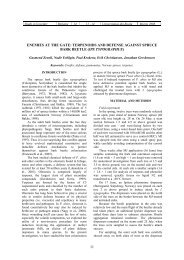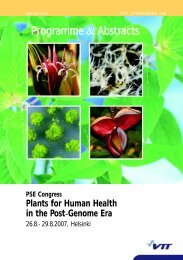Oecologia-2006
You also want an ePaper? Increase the reach of your titles
YUMPU automatically turns print PDFs into web optimized ePapers that Google loves.
<strong>Oecologia</strong> (<strong>2006</strong>) 148: 426–436<br />
DOI 10.1007/s00442-006-0394-3<br />
PLANTANIMALINTERACTIONS<br />
Nadir Erbilgin Æ Paal Krokene Æ Erik Christiansen<br />
Gazmend Zeneli Æ Jonathan Gershenzon<br />
Exogenous application of methyl jasmonate elicits defenses in Norway<br />
spruce (Picea abies) and reduces host colonization by the bark beetle<br />
Ips typographus<br />
Received: 2 August 2005 / Accepted: 7 February <strong>2006</strong> / Published online: 3 March <strong>2006</strong><br />
Ó Springer-Verlag <strong>2006</strong><br />
Abstract The terpenoid and phenolic constituents of<br />
conifers have been implicated in protecting trees from<br />
infestation by bark beetles and phytopathogenic fungi,<br />
but it has been difficult to prove these defensive roles<br />
under natural conditions. We used methyl jasmonate, a<br />
well-known inducer of plant defense responses, to<br />
manipulate the biochemistry and anatomy of mature<br />
Picea abies (Norway spruce) trees and to test their<br />
resistance to attack by Ips typographus (the spruce bark<br />
beetle). Bark sections of P. abies treated with methyl<br />
jasmonate had significantly less I. typographus colonization<br />
than bark sections in the controls and exhibited<br />
shorter parental galleries and fewer eggs had been<br />
deposited. The numbers of beetles that emerged and<br />
mean dry weight per beetle were also significantly lower<br />
in methyl jasmonate-treated bark. In addition, fewer<br />
beetles were attracted to conspecifics tunneling in methyl<br />
jasmonate-treated bark. Stem sections of P. abies treated<br />
with methyl jasmonate had an increased number of<br />
traumatic resin ducts and a higher concentration of<br />
terpenes than untreated sections, whereas the concentration<br />
of soluble phenolics did not differ between<br />
treatments. The increased amount of terpenoid resin<br />
Communicated by Richard Lindroth<br />
N. Erbilgin (&)<br />
Division of Insect Biology Department of Environmental Science,<br />
Policy and Management University of California,<br />
140 Mulford Hall, Berkeley, CA 94720, USA<br />
E-mail: erbilgin@nature.berkeley.edu<br />
Tel.: +1-510-6425806<br />
Fax: +1-510-6427428<br />
P. Krokene Æ E. Christiansen<br />
Norwegian Forest Research Institute, Høgskoleveien 8,<br />
1432 A˚ s, Norway<br />
G. Zeneli Æ J. Gershenzon<br />
Max Planck Institute for Chemical Ecology,<br />
Hans-Kno¨ ll-Straße 8, 07745 Jena, Germany<br />
present in methyl jasmonate-treated bark could be<br />
directly responsible for the observed decrease in I. typographus<br />
colonization and reproduction.<br />
Keywords Conifers Æ Induced defenses Æ Phenolics Æ<br />
Terpenes<br />
Introduction<br />
Bark beetles (Coleoptera: Scolytidae) feed, mate and<br />
oviposit in the subcortical tissues of host trees, and some<br />
species must attack and kill living trees in order to<br />
complete their life cycles. During the initial phase of host<br />
selection, beetles respond to visual (Strom et al. 1999) or<br />
chemical cues (Byers et al. 1988; Borden 1989), and enter<br />
or leave the host based on short-range chemical and<br />
tactile stimuli (Moeck et al. 1981; Raffa and Berryman<br />
1983). If the host is acceptable, the beetles bore through<br />
the outer bark, excavate a nuptial chamber in the<br />
phloem and produce aggregation pheromones that attract<br />
conspecifics (Wood 1982). After mating, the female<br />
excavates egg galleries and deposits eggs along the gallery<br />
walls. The developing larvae feed on phloem and/or<br />
fungi in the larval galleries. The full development from<br />
egg to adult takes from one month to several years,<br />
depending on the species.<br />
As the adult bark beetles enter the tree they introduce<br />
a variety of microorganisms, including phytopathogenic<br />
fungi. Conifers appear to have evolved sophisticated<br />
constitutive and inducible defense mechanisms against<br />
bark beetle colonization (reviewed by Franceschi et al.<br />
2005). In the Pinaceae, terpenoid and phenolic compounds<br />
seem to play a central role in the constitutive<br />
defense system. These chemicals occur in phenolic<br />
parenchyma cells, resin ducts, resin blisters, and resin<br />
cells in the phloem and xylem (Bannan 1936; Hudgins<br />
et al. 2004) and provide immediate resistance to invasion.<br />
An invasion also activates inducible defenses,<br />
which may include secondary resin production (Raffa
427<br />
and Berryman 1983; Christiansen 1985; Croteau et al.<br />
1987; Alfaro 1995; Klepzig et al. 1995; Luchi et al. 2005)<br />
and production of additional phenolics, leading to<br />
qualitative and quantitative changes in chemical composition<br />
(Brignolas et al. 1995; Klepzig et al. 1995; Bonello<br />
and Blodgett 2003; Lieutier et al. 2003; Blodgett<br />
et al. 2005). Collectively, these constitutive and inducible<br />
compounds may deter beetle invasion, impede fungal<br />
growth, and seal entrance wounds (Berryman 1972;<br />
Klepzig et al. 1995; Phillips and Croteau 1999; Franceschi<br />
et al. 2005). However, to date, researchers have<br />
found it difficult to prove the exact role of host chemistry<br />
in bark beetle defense because of the difficulties<br />
involved with manipulating these biochemical pathways.<br />
We are thus exploring new ways to manipulate inducible<br />
defenses of conifers in a realistic experimental setting.<br />
Jasmonates are endogenous plant phytohormones<br />
that are involved in defense signaling (Creelman and<br />
Mullet 1997). They have been intensively studied in the<br />
context of induced defense against herbivores (Creelman<br />
and Mullet 1997; Thaler et al. 2001). While most of this<br />
work has been done on angiosperms, there is growing<br />
evidence that jasmonates also induce defensive compounds<br />
in gymnosperms (Yukimune et al. 1996; Ketchum<br />
et al. 1999; Richard et al. 2000; Franceschi et al.<br />
2002; Martin et al. 2002; Hudgins and Franceschi 2004).<br />
For example, methyl jasmonate (MJ) induces extensive<br />
biochemical and anatomical changes in Norway spruce,<br />
Picea abies (L.) Karst., similar to those caused by<br />
pathogens or artificial wounding (Franceschi et al. 2002;<br />
Martin et al. 2002, 2003). These putative defensive responses<br />
have recently been implicated in protection<br />
against the bark beetle-associated fungus, Ceratocystis<br />
polonica (Zeneli et al. <strong>2006</strong>).<br />
In the present investigation, we studied the host colonization<br />
process of the spruce bark beetle Ips typographus<br />
(L.) in mature Norway spruce trees treated with<br />
MJ. I. typographus is the most aggressive tree-killing<br />
bark beetle in Europe and has killed more than 50 million<br />
m 3 of Norway spruce in large outbreaks since the<br />
late 1940s (Worrell 1983; Christiansen and Bakke 1988).<br />
To test whether induced responses of P. abies to MJ also<br />
have the potential to defend against bark beetles, we<br />
applied MJ to mature trees in a forest stand and evaluated<br />
colonization of Norway spruce by I. typographus<br />
in the field and laboratory.<br />
Materials and methods<br />
Standing tree experiment<br />
The objective of this experiment was to investigate the<br />
effects of MJ treatment on beetle colonization of live<br />
trees. In the spring of 2003, twelve trees were randomly<br />
selected in a naturally regenerated stand of mature<br />
Norway spruce in A˚ s, South East Norway [60 years old,<br />
tree height 28 m, diameter at breast height 27.85±3.09<br />
(SD) cm]. The population level of I. typographus in the<br />
area was low to moderate during the course of the<br />
experiments. On 26 May, a stem section between 1.5 and<br />
4.5 m above ground was divided into east- and westfacing<br />
halves by two vertical lines, using a water-based<br />
latex paint. One half of each tree was treated with<br />
100 mM MJ and the other half was left untreated to<br />
serve as a control (MJ C ). MJ was sprayed onto the stem<br />
using a small spray gun, while carefully avoiding contamination<br />
of the control side.<br />
Three weeks after MJ application, four samples<br />
containing the bark and outermost sapwood (1.6 cm<br />
wide · 5 cm high · 1 cm deep) were removed for anatomical<br />
investigation from each tree at 1.5 and 3.5 m<br />
above ground, two on the treated side and two on the<br />
control side. At each site a smaller sample<br />
(1.6·1.6·1 cm) for analyzing terpenes and phenolics was<br />
removed, quickly frozen on liquid N 2 and transferred to<br />
a 80 °C freezer. The anatomical samples were immediately<br />
placed in fixative (2% paraformaldehyde and<br />
1.25% glutaraldehyde in 50 mM L-piperazine-N-N¢bis(2-ethane<br />
sulfonic) acid buffer, pH 7.2).<br />
On 17 June, an Ipslure pheromone dispenser (Borregaard,<br />
Sarpsborg, Norway) was placed on each tree<br />
2 m above ground to induce attack by I. typographus.<br />
The dispensers were placed on the north side of the trees<br />
on the border between the MJ-treated and untreated<br />
sides. Because the beetle population in the area was<br />
relatively low and the main flight of the beetles had already<br />
taken place, an additional Ipslure dispenser was<br />
added 3 days later to enhance attraction. Beetle aggregation<br />
remained moderate on all trees except one, which<br />
was located on the south-facing edge of the stand. This<br />
tree was mass-attacked and killed by the beetles, as<br />
opposed to the other 11 trees, which survived with<br />
moderate attacks. The pheromone dispensers remained<br />
on the stems until 25 July, when the trees were sampled<br />
to assess beetle success.<br />
To assess beetle attacks, the outer cork bark was<br />
carefully shaved away on both sides of trees at the dispenser<br />
height. A transparent plastic sheet (210·297 mm)<br />
was placed on the stem within the shaved area, with the<br />
long side oriented vertically, and well away from the<br />
dividing lines between the two treatments. All entrance<br />
holes covered by the sheet and penetrating into the live<br />
phloem were marked, and the more developed beetle<br />
galleries were traced. On 26 August, the trees were<br />
sampled again immediately above the first sampling site,<br />
using the same method. The tree that had been massattacked<br />
and killed was excluded from the experiment,<br />
since the entire bark was crowded with well-developed<br />
beetle galleries. In the laboratory we recorded the<br />
number of entrance holes and incipient galleries (tunnels<br />
>10 mm length), and the total length of all maternal<br />
galleries on the plastic sheets. When multiple galleries<br />
extended from a single entrance hole, we recorded the<br />
sum of their lengths.<br />
On 24 July, 2003, 12 other Norway spruce trees in the<br />
same stand (DBH=28.59±3.19 cm) were treated with<br />
MJ as described above to see if MJ treatment in one year
428<br />
would have any effects on beetle colonization the following<br />
year. Samples for anatomical and chemical<br />
analyses were removed from the trees the following<br />
spring (12 May 2004) as described above, and two days<br />
later the trees were baited with pheromone dispensers to<br />
induce attack by I. typographus. At this stage, there was<br />
extensive resin flow in some trees on bark that had been<br />
treated with MJ. On 16–17 June 2004, the outer bark<br />
was removed and the outcome of the beetle attacks was<br />
assessed as described above.<br />
In both years, all anatomical samples were taken to<br />
the laboratory and processed as described in Krokene<br />
et al. (2003). Briefly, samples were rinsed with buffer,<br />
dehydrated in a graded series of ethanol, and embedded<br />
in acrylic resin. Cross-sections (1 lm thick) were cut on<br />
a diamond knife, dried onto gelatin-coated slides,<br />
stained with Stevenel’s blue (Del Cerro et al. 1980), and<br />
mounted with immersion oil. Digital images were recorded<br />
at a magnification of 5· using a Leica (Solms,<br />
Germany) DC300 CCD camera mounted on a Leitz<br />
(Oberkochen, Germany) Aristoplan photomicroscope.<br />
The extent of traumatic resin duct (TD) formation in the<br />
xylem was quantified as the percentage of tracheid lanes<br />
that contained TDs (including the epithelial cells lining<br />
the ducts) across the full tangential width of each section<br />
(1,380 lm).<br />
Petri dish assay<br />
The objective of this experiment was to investigate the<br />
effects of MJ treatment on beetle colonization, egg laying,<br />
and attraction of conspecifics. The population level<br />
of I. typographus in the area was low to moderate during<br />
the course of the experiments. On 7 May 2004, a 3 m<br />
section of the lower stem of a 40-year-old clonal Norway<br />
spruce tree growing in A˚ s, South East Norway was<br />
treated in the same way as in the standing tree experiment,<br />
with half the bark circumference treated with<br />
100 mM MJ and the other half left untreated. Three and<br />
a half weeks later the tree was felled and the 3 m stem<br />
section was cut into four bolts. An untreated ramet of<br />
the same clone was felled and sectioned the same way.<br />
The bolts were sealed at both ends with melted paraffin<br />
wax to minimize desiccation, and stored at 4 °C for later<br />
use.<br />
Assay units consisted of fresh bark-phloem disks in<br />
large Petri dishes (150 mm in diameter, 25 mm deep), as<br />
described by Erbilgin and Raffa (2000). Briefly, phloem<br />
and outer bark were peeled off the stored bolts and cut<br />
into 150 mm-diameter disks (177 cm 2 ) using a hole saw.<br />
The disks were then placed with the cambium facing<br />
downwards in Petri dishes with melted paraffin wax<br />
applied to the bottom and edges of the disks to minimize<br />
desiccation of the phloem. Three treatments were tested:<br />
(1) bark from the treated half of the MJ-treated tree<br />
(MJ), (2) bark from the untreated half of the same tree<br />
(MJ C ), and (3) bark from the untreated ramet (control).<br />
Bark beetles were collected in traps baited with Ipslure<br />
pheromone dispensers and kept at 60–65% RH and 4 °C<br />
for up to ten days until use. The beetles used in the<br />
assays were not sexed beforehand, because male and<br />
female I. typographus cannot be reliably distinguished<br />
based on external morphology. Beetles were sexed after<br />
the experiment by dissecting their genitals under the<br />
microscope. However, traps with synthetic pheromones<br />
are known to capture roughly equal amounts of each<br />
sex, and to ensure that both sexes would be present in<br />
each assay unit, we introduced ten beetles per unit. The<br />
Petri dishes were covered by a mesh screen to prevent the<br />
beetles from escaping.<br />
The beetles were allowed to colonize the bark disks<br />
for 24 h at 23 °C before the units were suspended from<br />
flight interception traps in the field. The traps consisted<br />
of two thin sheets of clear acrylic plastic (39 cm<br />
high · 21 cm wide) mounted vertically and crosswise<br />
over a plastic funnel (22 cm diameter) fitted with a collecting<br />
bottle. One assay unit was placed as bait within<br />
the funnel, just below the plastic sheets. Fifteen traps<br />
were deployed in openings within a spruce stand, constituting<br />
five blocks in a randomized complete block<br />
design, with 15 m between treatments within a block and<br />
50 m between blocks. The traps were placed with the<br />
collecting bottle hanging close to the top of the ground<br />
vegetation. The assay units were replaced with fresh<br />
units (prepared from the cold stored bolts) and re-randomized<br />
every five days over a period of 15 days (3–17<br />
June, 2004), providing a total of 15 replicates per<br />
treatment.<br />
After each five-day trapping period, the bark disk<br />
was dissected immediately, and the number of male entrance<br />
holes, the number of maternal galleries, the total<br />
length of maternal galleries and the total number of egg<br />
niches were recorded per disk. Only beetles that had<br />
tunneled more than 10 mm were considered to be successful<br />
colonizers. Insects caught in the traps were<br />
identified to species and sexed after dissection under the<br />
microscope.<br />
Log experiment<br />
Another experiment was conducted to investigate effects<br />
of MJ treatment on brood production of I. typographus.<br />
We utilized two ramets of a different 40-year-old clone<br />
growing in the same stand that was used for the Petri<br />
dish experiment. The trees were treated in the same way<br />
as in the Petri dish assay, and on 15 June 2004 the trees<br />
were felled and cut into 40 cm-long bolts. This yielded<br />
eight bolts where half the bark circumference was treated<br />
with MJ (MJ) and the other half was untreated<br />
(MJ C ), and eight bolts where the whole bark area was<br />
untreated (control). Pairs of bolts (one from each type)<br />
were placed vertically on the forest floor in a randomized<br />
block design and baited with an Ipslure pheromone<br />
dispenser placed between the bolts. The distance between<br />
bolts within a pair was 0.5 m and the distance<br />
between pairs was 50 m. Bolts were left in the field for
429<br />
seven days for colonization by I. typographus and then<br />
brought to an outdoor insectary. The bolts were split<br />
longitudinally through the center to separate the MJand<br />
MJ C -treatments, and each half-bolt was sealed with<br />
melted paraffin wax on the cut surfaces to minimize<br />
desiccation. Control bolts were split and treated in the<br />
same way as the MJ-treated bolts. This procedure yielded<br />
32 half-bolts that were hung individually inside fine<br />
mesh cloth bags with funnels and collection bottles attached<br />
to the lower end, to collect emerging beetles.<br />
In October–November 2004, we counted the number<br />
of beetles that had emerged from each half-bolt. Because<br />
there still were beetles in the bolts, we also estimated the<br />
number of remaining beetles by counting the numbers<br />
under two randomly chosen 100 cm 2 (10·10 cm 2 ) areas<br />
of bark on each bolt. Furthermore, we determined beetle<br />
dry weight by weighing 100 randomly selected beetles<br />
per bolt (dried at 110 °C for 60 min). Beetles were<br />
weighed to an accuracy of 0.01 mg.<br />
Chemical analyses<br />
Terpene extractions were based on the procedures of<br />
Zeneli et al. (<strong>2006</strong>). Briefly, wood and bark tissue<br />
(100 mg each) were submerged separately in 1.5 ml of<br />
tert-butyl methyl ether containing 150 lg ml<br />
1 isobutylbenzene<br />
and 200 lg ml dichlorodehydroabietic<br />
1<br />
acid as internal standards. The tissue samples were extracted<br />
over 14 h with constant shaking at room temperature.<br />
The ether extract was transferred to a fresh vial<br />
and washed with 0.3 ml of 0.1 M (NH 4 ) 2 CO 3 (pH 8.0) to<br />
purify extracted terpenes from other small organic acids.<br />
The extract was then split into two equal portions. One<br />
portion of the extract was prepared for monoterpene<br />
and sesquiterpene analysis by filtering through a Pasteur<br />
pipette column filled with 0.3 g of silica gel (Sigma 60 A˚ )<br />
overlaid with 0.2 g of anhydrous MgSO 4 . The column<br />
was washed with 1 ml of diethyl ether, and the eluent<br />
was collected in a fresh vial. Finally, the sample was<br />
concentrated to an approximate volume of 100 ll that<br />
was stored at 20 °C until analysis. In the second portion<br />
of the extract, the diterpene resin acids were<br />
methylated by adding 50 ll of 0.2 M N-trimethylsulfonium<br />
hydroxide in methanol (Macherey-Nagel GmbH &<br />
Co, Germany) to 0.4 ml of the washed ether extract in a<br />
separate vial and incubated at room temperature for 2 h<br />
to allow the methylation reaction to go to completion.<br />
The solvent was then evaporated under nitrogen to<br />
about 100 ll, leaving the residual methyl-esterified diterpene<br />
fraction for analysis via GC-MS.<br />
A Hewlett–Packard (Palo Alto, CA, USA) 6890 GC-<br />
MSD system, using a DB-5 MS column<br />
(30 m · 0.25 mm · 0.25 lm, J&W Scientific, Folsom,<br />
CA, USA), was used for the GC-MS analysis of monoterpenes<br />
and sesquiterpenes. Split injections (1 ll ether<br />
extract) were made at a ratio of 1:5 for wood and 1:10<br />
for bark samples with an injector temperature of 220 °C.<br />
The instrument was run under the same program<br />
described by Zeneli et al. (<strong>2006</strong>). Identification of terpenes<br />
was based on comparison of retention times and<br />
mass spectra with authentic standards or with mass<br />
spectra in the Wiley or National Institute of Standards<br />
and Technology libraries.<br />
Analysis of diterpene constituents was performed on<br />
the same GC-MS instrument fitted with the same DB-5<br />
MS column. Injections were made with 1 ll of the<br />
concentrated, derivatized ether extracts. GC-MS split<br />
ratios were 1:10 (for both wood and bark extracts) with<br />
an injector temperature of 220 °C. The temperature<br />
programs for the instrument are described by Zeneli<br />
et al. (<strong>2006</strong>). GC-MS generated peaks were quantified<br />
using Hewlett–Packard Chemstation software. For<br />
quantitative analysis of monoterpenes, sesquiterpenes<br />
and diterpenes, the MS detector was operated in the<br />
SIM mode. The selected ions for the internal standards,<br />
monoterpenes, sesquiterpenes and diterpene methyl esters<br />
are described by Zeneli et al. (<strong>2006</strong>). The total<br />
monoterpene, sesquiterpene or diterpene resin acid<br />
content was calculated as the sum of the individually<br />
quantified compounds.<br />
Extraction of phenolic constituents was modified<br />
from Laitinen et al. (2002) as described by Zeneli et al.<br />
(<strong>2006</strong>). Briefly, wood and bark tissues were weighed<br />
(100 mg) and extracted separately with 2.5 ml of methanol<br />
(100%) using an Ultra-Turrax (IKA-WERKE,<br />
Staufen, Germany) homogenizer for 30 s, after which<br />
the sample was left for 15 min on ice. The sample was<br />
then centrifuged (16,000g, 3 min) and decanted. The<br />
pellet was extracted three more times by homogenization<br />
for 30 s, placed for 2 min on ice, and then centrifuged.<br />
The combined supernatants were vacuum-evaporated to<br />
dryness, redissolved in 1 ml of 100% methanol, and<br />
transferred to a fresh vial for analysis. After being<br />
evaporated to dryness again under nitrogen, they were<br />
stored at 20 °C.<br />
The quantitative analysis of phenolics of wood and<br />
bark samples was carried out by high-performance liquid<br />
chromatography (HPLC) using a Hewlett–Packard<br />
system with a quaternary pump (HP 1050), an autosampler<br />
(HP 1100 at 230 nm), a photodiode array<br />
detector (HP 1100), HP ChemStation Software, and a<br />
5 lm Lunal C18 column (250·4.6 mm 2 ID) (Phenomenex,<br />
Torrance, CA, USA). The mobile phases used were<br />
0.2% trifluoroacetic acid and acetonitrile. The gradients<br />
for separation and identification of the compounds are<br />
described by Zeneli et al. (<strong>2006</strong>).<br />
Data analyses<br />
Data were analyzed using analysis of variance. Each<br />
variable was tested to check that it satisfied assumptions<br />
of normality and homogeneity of variances (Zar<br />
1996) by graphical analysis of residuals (Neter et al.<br />
1983). If the variance was nonhomogeneous, variables<br />
were transformed to square root, which provided<br />
distributions that satisfied these assumptions in all
430<br />
cases. Sex ratio and proportional data for I. typographus<br />
were transformed by arcsinÖy. Beetle colonization<br />
data from the standing tree experiment were analyzed<br />
on a single-tree basis, by using the calculated differences<br />
between MJ-treated and untreated bark within<br />
trees as the response variable. The data were subjected<br />
to one-sample t-tests using SYSTAT (SPSS Inc.,<br />
Chicago, IL, USA). Dependent variables in the Petri<br />
dish assay and log experiment were analyzed by repeated<br />
measure analysis in Proc Mixed (Littell et al.<br />
1996), as a split plot, with randomized block design,<br />
treating sites, bark discs, or logs as blocks. For each<br />
variable, covariance parameter estimates (REML) for<br />
block and block by treatment were calculated in order<br />
to reveal the extent of variability due to block or<br />
block by treatment interaction. In all experiments,<br />
blocks were accepted as a random factor; if the<br />
covariance parameter of a block was zero, the block<br />
term was eliminated from the random statement in the<br />
model. Tukey’s Protected LSD test was used for<br />
multiple comparisons of means.<br />
Results<br />
Methyl jasmonate reduced I. typographus colonization<br />
of P. abies bark<br />
In the standing tree experiments, no tunnels extended<br />
more than 50 mm from the entrance hole in the 11<br />
surviving trees and no oviposition took place; this allowed<br />
comparison of the number and length of attacks<br />
between MJ-treated and untreated bark without considering<br />
attack success.<br />
In 2003, MJ-treated bark (MJ) sustained significantly<br />
less bark beetle colonization than untreated bark on the<br />
same tree (MJ C ), at both the lower and upper sampling<br />
positions (Fig. 1; P=0.0001–0.05). Treated bark had an<br />
average of 31% fewer entrance holes, 69% fewer galleries,<br />
and gallery length was 82% shorter than in untreated<br />
bark. All of these differences were statistically<br />
significant (Fig. 1). The difference between MJ C and<br />
MJ-treated bark was significantly greater for total gallery<br />
length (MJ C :MJ ratio of 6.53) than for number of<br />
incipient galleries and entrance holes (MJ C :MJ ratios of<br />
2.40 and 1.66, respectively (F=4.48, P=0.015). This<br />
suggests that the negative impact of MJ increased as the<br />
beetles proceeded through the colonization sequence<br />
from first entry into the bark to sustained tunneling<br />
activity. Beetle colonization also varied significantly<br />
with sampling position, with more colonization on the<br />
lower position, which was closer to the pheromone<br />
source (F=4.24–13.75, P=0.0006–0.04 for the different<br />
colonization variables). These lower samples were<br />
probably more influenced by the proximity to the<br />
pheromone dispenser itself, and thus the upper samples<br />
should give a more unbiased view of beetle attack<br />
behavior. The effect of MJ treatment (measured as the<br />
difference between MJ C and MJ-treated bark within<br />
each tree) did not differ between sampling positions<br />
(F=0.01–2.06, P=0.17–0.94 for the different colonization<br />
variables).<br />
In 2004, one year after MJ treatment, I. typographus<br />
attacks were induced on 12 previously unattacked trees.<br />
Although the number of beetle attacks in 2004 was much<br />
lower than in 2003 (115 vs. 434 attacks/m 2 , respectively;<br />
F=82.51, P
431<br />
In the Petri dish assays, the number of beetle entrance<br />
holes in fresh bark disks did not vary among treatments,<br />
suggesting that MJ application did not affect the entry<br />
behavior of I. typographus (Table 1). However, in these<br />
assays MJ had significant effects on beetle behavior<br />
within the bark. The number of parental galleries, length<br />
of galleries, and number of eggs were all significantly<br />
higher in MJ-free than in MJ-treated bark (Table 1).<br />
There were no significant differences between disks from<br />
untreated parts of MJ-treated trees and those from<br />
completely untreated trees. The male:female ratio in<br />
each assay unit was similar among treatments<br />
[F (2,24) =1.09, P=0.367 sex by treatment interaction],<br />
and ranged from 0.47 to 0.55.<br />
Methyl jasmonate reduced I. typographus aggregation<br />
Attraction of I. typographus by conspecifics that had<br />
colonized MJ-treated or untreated bark was tested by<br />
attaching Petri dishes with boring beetles to flight<br />
interception traps. A total of 273 bark beetle specimens<br />
were captured in these traps across treatments, including<br />
170 I. typographus (89 female, 81 male), 25 Hylastes<br />
cunicularius, 43Dryocoetes autographus, and 35 Pityogenes<br />
chalcographus. Use of MJ-treated bark disks significantly<br />
reduced the number of beetles attracted, as<br />
male I. typographus excavating in MJ-treated bark attracted<br />
fewer conspecifics than males excavating in MJ C<br />
bark or control bark (Table 2). There was also a significant<br />
effect of time [F (2,24) =30.97, P0.99 for linear regression of<br />
Table 1 Bark beetle colonization of Norway spruce bark treated with methyl jasmonate (MJ) and untreated bark (Control = bark from<br />
untreated trees; MJ C = bark from untreated parts of MJ-treated trees)<br />
No. entrance holes a No. galleries Gallery length (cm) No. egg niches<br />
Control 5.47±0.26 3.60±0.35 a 19.83±2.86 a 36.67±8.65 a<br />
MJ C 5.13±0.32 4.07±0.48 a 22.30±2.25 a 45.53±6.30 a<br />
MJ 5.53±0.24 2.47±0.31 b 9.33±1.29 b 10.80±3.10 b<br />
F (2,12) 0.71 5.55 17.48 14.31<br />
P 0.5125 0.0196
432<br />
Table 2 Response of flying bark beetles to male and female Ips typographus tunneling in Norway spruce bark treated with methyl<br />
jasmonate (MJ) and untreated bark (Control = bark from untreated trees; MJ C = bark from untreated parts of MJ-treated trees)<br />
Number of insects of each species trapped<br />
I. typographus P. chalcographus D. autographus H. cunicularius<br />
Control 5.00±0.82 a 1.33±0.44 a 1.20±0.29 0.73±0.18<br />
MJ C 5.00±1.08 a 0.87±0.38 a 0.93±0.43 0.60±0.27<br />
MJ 1.33±0.33 b 0.13±0.09 b 0.73±0.27 0.33±0.19<br />
F (2,12) 13.72 4.09 0.33 0.86<br />
P 0.0008 0.044 0.723 0.448<br />
Means (number of insects caught per trap and five-day collection period) followed by the same letter in a column are not significantly<br />
different at P
433<br />
The number of beetles produced and mean dry weight<br />
per beetle were also significantly lower in MJ-treated<br />
bark. Furthermore, fewer beetles were attracted to<br />
conspecifics tunneling in MJ-treated bark.<br />
These effects are discussed in relation to the host<br />
colonization sequence of bark beetles, from host selection<br />
to concentration, establishment and dispersal<br />
(Wood 1982), as shown diagrammatically in Fig. 2. The<br />
selection phase begins when the beetles respond to host<br />
stimuli before or after landing on the bark, and ends<br />
with sustained feeding in the phloem. MJ treatment did<br />
not appear to have strong effects on the beetle’s decision<br />
to enter the bark (cf. the first two experiments), and<br />
hence any influence of MJ on host selection before or<br />
shortly after landing on the host is also likely to be small<br />
(Phase 1). However, the absence of clear effects of MJ on<br />
beetle entry could be due to our use of synthetic aggregation<br />
pheromones to initiate attacks on the trees. The<br />
pheromone emission from the dispensers corresponds to<br />
about 200 pheromone-producing males (Birgersson and<br />
Bergstro¨ m 1989), and this signal might override any<br />
deterring effects of MJ treatment and so increase the<br />
propensity of the beetles to enter unsuitable hosts<br />
(Borden 1982; Camacho et al. 1994). However, since MJ<br />
did not affect entry behavior in the bark disc assay where<br />
no pheromones were used, this possibility seems unlikely.<br />
We did not test for an effect of MJ on primary<br />
Hypothetical Effects of Methyl<br />
Jasmonate Application to<br />
Mature Norway Spruce<br />
Phase 1:<br />
Host Selection<br />
Phase 2:<br />
Host Colonization<br />
Phase 3:<br />
Host Establishment<br />
Phase 4:<br />
Dispersal<br />
Before Landing: Host Selection: ?<br />
After Landing: Host Selection: ?<br />
Entering: NO?<br />
Attraction: YES<br />
Gallery Construction: YES<br />
Egg Laying: YES<br />
Brood Production/Survival: YES<br />
Emergence: YES<br />
Dispersal: ?<br />
Fig. 2 Conceptual diagram of the different stages in I. typographus<br />
host selection and development with an indication of whether<br />
(YES) or not (NO) methyl jasmonate treatment had an effect on<br />
each stage. See text for further details<br />
(host-induced) attraction of ‘‘pioneer beetles’’ (the first<br />
beetles to arrive on a tree). However, the total emission<br />
of volatile terpenes has been shown to increase fivefold<br />
after foliar application of MJ on two-year-old saplings,<br />
with individual compounds such as (E)-b-farnesene and<br />
linalool increasing up to 100-fold (Martin et al. 2003).<br />
These compounds are of particular ecological interest, as<br />
they have been reported to attract natural enemies of<br />
herbivores or repel herbivores directly in other plant<br />
species (Kessler and Baldwin 2001; Pichersky and Gershenzon<br />
2002). The possibility that similar effects occur<br />
in the Norway spruce-I. typographus system deserves<br />
further investigation.<br />
The concentration phase begins when flying beetles<br />
respond to aggregation pheromones and/or host compounds<br />
(secondary attraction), continues with the production<br />
of more aggregation pheromones, and ends with<br />
the production of antiaggregation pheromones (Phase 2/<br />
Fig. 2). This process is crucial to the survival of the<br />
dispersing population of tree-killing bark beetles, since<br />
they rely on mass attacks of host trees to obtain substrate<br />
for larval development. Fewer I. typographus were<br />
attracted to beetles tunneling in MJ-treated bark as<br />
compared to beetles tunneling in untreated bark. Shorter<br />
gallery length in MJ-treated bark might be a reflection of<br />
differences in host quality and thus beetle attraction,<br />
since beetle attraction seems to be proportional to the<br />
extent of beetle tunneling. Similar results have been reported<br />
for the congeneric species I. pini Say (Erbilgin<br />
and Raffa 2000). Interference of plant defenses induced<br />
by MJ on pheromone emission could also explain the<br />
lower attraction of beetles in the current study. For<br />
example, Raffa and Berryman (1983) found that Dendroctonus<br />
ponderosae Hopkins beetles that were continuously<br />
fighting resin defenses in vigorous trees were<br />
unable to initiate mass attacks. Additional studies are<br />
necessary to understand how MJ interferes with pheromone<br />
production and communication in I. typographus.<br />
Methyl jasmonate strongly inhibited the establishment<br />
phase of host colonization, which begins when the<br />
mortality of the host trees is assured (Phase 3/Fig. 2).<br />
This phase starts with the initiation of mating, gallery<br />
construction and oviposition and ends when elongation<br />
of egg galleries and oviposition cease. MJ treatment<br />
strongly influenced gallery construction and egg laying<br />
by I. typographus. Even though the total number of attacks<br />
was similar on both the treated and untreated sides<br />
of the trees, incipient gallery construction was much less<br />
extensive on the MJ-treated side, indicating that these<br />
tissues were less suitable for the beetles. One plausible<br />
explanation is that chemical changes in the phloem affected<br />
the ability or propensity of bark beetles to excavate<br />
host tissues and lay eggs. We do not currently know<br />
whether I. typographus is negatively affected by increased<br />
quantities of terpenes, but studies on I. pini<br />
indicate that tunneling in a phloem-based medium decreases<br />
with increasing concentration of a-pinene in the<br />
medium (Wallin and Raffa 2000). The phytopathogenic<br />
fungal associates of the beetles play a crucial role during
434<br />
the establishment phase by helping to overcome tree<br />
resistance (Paine et al. 1997). Even though we did not<br />
evaluate the effects of our treatment on fungal colonization,<br />
other studies have shown that MJ treatment increases<br />
resistance to C. polonica and other pathogens in<br />
Norway spruce (Kozlowski et al. 1999; Franceschi et al.<br />
2002; Schmidt et al. 2005; Zeneli et al. <strong>2006</strong>). Thus, MJ<br />
treatment might well have affected beetle colonization<br />
via its effect on the fungal associates.<br />
Methyl jasmonate application also reduced both the<br />
quality and quantity of brood production by I. typographus.<br />
These results agree with studies showing that<br />
bark beetles colonizing trees whose defenses had been<br />
induced usually experience increased levels of egg and<br />
larval mortality (Nebeker et al. 1993; Raffa and Smalley<br />
1995). For example, I. typographus was less successful in<br />
attacking Norway spruce that had been elicited by a<br />
sublethal number of inoculations with the fungus C.<br />
polonica (Christiansen and Krokene 1999).<br />
The dispersal phase includes offspring emergence<br />
from natal trees and response to host stimuli and/or<br />
aggregation pheromones. MJ application is likely to<br />
have negatively influenced the fitness and dispersal<br />
ability of emerging beetles by reducing their body weight<br />
and lipid content (Phase 4/Fig. 2). Although we did not<br />
determine lipid content directly, body weight and lipid<br />
content are directly correlated in I. typographus (Anderbrant<br />
et al. 1985). Lipids are used as an energy source<br />
during dispersal (Slansky and Haack 1986), and have<br />
been shown to affect bark beetle survival, host colonization,<br />
host selection and reproduction (Anderbrant<br />
et al. 1985; Anderbrant 1988; Wallin and Raffa 2004).<br />
The anatomical and chemical changes induced by the<br />
application of MJ to P. abies in this study may be<br />
responsible for the increase in bark beetle resistance. MJ<br />
treatment has been suggested to increase resistance to<br />
herbivores and pathogens in previous studies in a similar<br />
manner (Kozlowski et al. 1999; Franceschi et al. 2002;<br />
Martin et al. 2002; Hudgins and Franceschi 2004; Zeneli<br />
et al. <strong>2006</strong>). However, further investigation is required to<br />
confirm this conclusion, since MJ could also have acted<br />
by increasing other chemical or physical defenses that<br />
were not measured. In the current study, MJ induced the<br />
formation of numerous traumatic resin ducts in the<br />
sapwood, and so it can be assumed to have increased the<br />
volume of resin available for repelling biological invaders<br />
and sealing off wounds. An increase in traumatic<br />
resin ducts has been implicated in defense against C.<br />
polonica, a pathogenic fungal associate of I. typographus<br />
(Krokene et al. 2003; Zeneli et al. <strong>2006</strong>).<br />
MJ application also induced a 2.5–3-fold increase in<br />
the terpene content of Norway spruce. Conifer terpenes,<br />
which include monoterpenes, sesquiterpenes, and diterpene<br />
resin acids (Phillips and Croteau 1999), are thought<br />
to be an important constitutive defense against insect<br />
and pathogen attack (Berryman 1972; Raffa and Berryman<br />
1983; Christiansen 1985). The terpene response to<br />
MJ treatment was negatively correlated with the degree<br />
of bark beetle colonization, since colonization was less<br />
successful in 2003, when the terpene response was<br />
strong, as compared to 2004, when the terpene response<br />
was weaker. The increased terpene levels lasted longer in<br />
the wood than in the bark, probably because much of<br />
the wood terpene is stored for a much longer time in the<br />
traumatic resin ducts and/or because the ducts continued<br />
to synthesize terpenes. Traumatic resin ducts may<br />
remain active for several years (Nagy et al. 2000). The<br />
terpene response in this study is consistent with a previous<br />
report on MJ treatment of mature P. abies (Zeneli<br />
et al. <strong>2006</strong>).<br />
The physical distribution and chemical content of<br />
traumatic resin ducts may provide a formidable<br />
obstacle to attack and growth of invasive organisms.<br />
However, traumatic resin duct development usually<br />
requires 2–4 weeks, which is not fast enough to repel a<br />
rapid attack of bark beetles (Franceschi et al. 2000;<br />
Nagy et al. 2000). Other more rapidly inducible defenses<br />
may function in this capacity. In addition to<br />
traumatic resin ducts, MJ application to conifers has<br />
also been shown to cause the activation and proliferation<br />
of polyphenolic parenchyma (PP) cells (Hudgins<br />
et al. 2003, 2004; Hudgins and Franceschi 2004) and<br />
to induce several enzymes of phenolic biosynthesis<br />
(Richard et al. 2000). The PP cells are primary sites of<br />
phenolic biosynthesis and other defense responses in<br />
the secondary phloem (Franceschi et al. 1998, 2000).<br />
However, in the current study MJ treatment did not<br />
cause any change in the content of soluble phenolic<br />
compounds. Similarly, Brignolas et al. (1998) found no<br />
changes in stilbene aglycones, a major group of soluble<br />
phenolic compounds, in fungus-inoculated phloem<br />
of P. abies. In any case, the defensive role of the<br />
stilbenes, flavonoids and other simple phenolics studied<br />
to date is ambiguous (Woodward and Pearce 1988;<br />
Evensen et al. 2000; McNee et al. 2003). The striking<br />
anatomical changes that take place in the PP cells<br />
after MJ application or fungal infection (Franceschi<br />
et al. 1998, 2000) may be associated with increases in<br />
more complex phenolics, such as high molecular<br />
weight condensed tannins (Maie et al. 2003) or cell<br />
wall-bound substances (Strack et al. 1988), but this<br />
remains to be tested (Bonello and Blodgett 2003;<br />
Blodgett et al. 2005).<br />
Despite the clear-cut results of this study, we are very<br />
cautious about inferring that MJ can be a useful tool for<br />
protecting trees from bark beetle attacks. We do not yet<br />
know the impact of MJ on long-term tree health nor the<br />
costs of the anatomical and chemical changes induced by<br />
MJ application with respect to growth and survival.<br />
Nevertheless, further research on MJ-treated P. abies<br />
and I. typographus might help answer these questions as<br />
well as identify the precise defensive changes responsible<br />
for reduced I. typographus colonization, attraction and<br />
reproduction, and provide other important new insights<br />
about tree defences against bark beetles. If MJ treatment<br />
can be eventually shown to prevent tree mortality caused<br />
by bark beetles, this could be of great benefit to the<br />
integrated management of these important forest pests.
435<br />
Acknowledgments This study was supported by the Norwegian<br />
Forest Research Institute, University of California-Berkeley (College<br />
of Natural Resources), and the Max Planck Society. Trygve<br />
Krekling and Elin Ørmen at the Electron Microscopy Laboratory,<br />
Norwegian University of Life Sciences helped with sample processing<br />
and microscopy. Torstein Kvamme, Skogforsk, helped with<br />
field and lab work. We gratefully acknowledge the permission to<br />
utilize trees in the municipal forest in A˚ s.<br />
References<br />
Alfaro RI (1995) An induced defence reaction in white spruce to<br />
attack by the white pine weevil, Pissodes strobi. Can J For Res<br />
25:1725–1730<br />
Anderbrant O (1988) Survival of parent and brood adult bark<br />
beetles, Ips typographus, in relation to size, lipid content and reemergence<br />
or emergence day. Physiol Ent 13:121–129<br />
Anderbrant O, Schlyter F, Birgersson G (1985) Intraspecific competition<br />
affecting parents and offspring in the bark beetle Ips<br />
typographus. Oikos 45:89–98<br />
Bannan MW (1936) Vertical resin ducts in the secondary wood of<br />
the abietineae. New Phytol 35:11–46<br />
Berryman AA (1972) Resistance of conifers to invasion by bark<br />
beetle-fungus associations. Bioscience 22:598–602<br />
Blodgett JT, Herms DA, Bonello P (2005) Effects of fertilization on<br />
red pine defense chemistry and resistance to Sphaeropsis sapinea.<br />
For Ecol Manag 208:373–382<br />
Birgersson G, Bergstro¨ m G (1989) Volatiles released from individual<br />
spruce bark beetle entrance holes—quantitative variations<br />
during the first week of attack. J Chem Ecol 15:2465–2483<br />
Bonello P, Blodgett JT (2003) Pinus nigra–Sphaeropsis sapinea as a<br />
model pathosystem to investigate local and systemic effects of<br />
fungal infection of pines. Physiol Mol Plant Path 63:249–261<br />
Borden JH (1982) Aggregation pheromones. In: Milton JB, Sturgeon<br />
KB (eds) Bark beetles in North American conifers. University<br />
of Texas Press, Austin, TX, pp 74–139<br />
Borden JH (1989) Semiochemials and bark beetle populations:<br />
exploitation of natural phenomena by pest management strategists.<br />
Hol Ecol 12:501–510<br />
Brignolas F, Lieutier F, Sauvard D, Yart A, Drouet A, Claudot<br />
AC (1995) Changes in soluble-phenol content of Norway spruce<br />
(Picea abies) phloem in response to wounding and inoculation<br />
with Ophiostoma polonicum. Eur J For Path 25:253–265<br />
Brignolas F, Lieutier F, Sauvard D, Christiansen E, Berryman AA<br />
(1998) Phenolic predictors for Norway spruce resistance to the<br />
bark beetle Ips typographus (Coleoptera : Scolytidae) and an<br />
associated fungus, Ceratocystis polonica. Can J For Res 28:720–<br />
728<br />
Byers JA, Birgersson G, Lofqvist J, Bergstro¨ m G (1988) Synergistic<br />
pheromones and monoterpenes enable aggregation and host<br />
recognition by a bark beetle. Naturwissenschaften 75:153–155<br />
Camacho AD, Pierce HD Jr, Borden JH (1994) Aggregation<br />
pheromones in Dryocoetes affaber (Mann.) (Coleoptera: Scolytidae):<br />
stereoisomerism and species specificity. J Chem Ecol<br />
20:111–124<br />
Christiansen E (1985). Ceratocystis polonica inoculated in Norway<br />
spruce: blue-staining in relation to inoculum density, resinosis<br />
and tree growth. Eur J For Path 15:160–167<br />
Christiansen E, Bakke A (1988) The spruce bark beetle of Eurasia.<br />
In: Berryman AA (eds) Dynamics of forest insect populations.<br />
Plenum, New York, pp 479–503<br />
Christiansen E, Krokene P (1999) Can Norway spruce trees be<br />
‘‘vaccinated’’ against attack by Ips typographus? Agric For Ent<br />
1:185–187<br />
Creelman RA, Mullet JE (1997) Biosynthesis and action of jasmonates<br />
in plants. Annu Rev Plant Physiol Plant Mol Biol<br />
48:355–381<br />
Croteau R, Gurkewitz S, Johnson MA, Fisk HJ (1987) Biochemistry<br />
of oleoresinosis: monoterpene and diterpene biosynthesis in<br />
lodgepole pine saplings infected with Cer-atocystis clavigera or<br />
treated with carbohydrate elicitors. Plant Physiol 85:1123–2840<br />
Del Cerro M, Cogen J, Del Cerro C (1980) Stevenel’s blue, an<br />
excellent stain for optical microscopical study of plastic<br />
embedded tissue. Microsc Acta 83:117–121<br />
Erbilgin N, Raffa KF (2000) Effects of host tree species on<br />
attractiveness of tunnelling pine engravers, Ips pini, to conspecifics<br />
and insect predators. J Chem Ecol 26:823–840<br />
Evensen PC, Solheim H, Hoiland K, Stenersen J (2000) Induced<br />
resistance of Norway spruce, variation of phenolic compounds<br />
and their effects on fungal pathogens. For Path 30:97–108<br />
Franceschi VR, Krekling T, Berryman AA, Christiansen E (1998)<br />
Specialized phloem parenchyma cells in Norway spruce (Pinaceae)<br />
bark are an important site of defence reactions. Am J Bot<br />
85:601–615<br />
Franceschi VR, Krokene P, Krekling T, Christiansen E (2000)<br />
Phloem parenchyma cells are involved in local and distant defense<br />
responses to fungal inoculation or bark-beetle attack in<br />
Norway spruce (Pinaceae). Am J Bot 87:314–326<br />
Franceschi VR, Krekling T, Christiansen E (2002) Picea abies<br />
(Pinaceae) stems induces defense-related responses in phloem<br />
and xylem. Am J Bot 89:602–610<br />
Franceschi VR, Krokene P, Christiansen E, Krekling T (2005)<br />
Anatomical and chemical defenses of conifer bark against bark<br />
beetles and other pests. New Phytol 167:353–376<br />
Hudgins JW, Franceschi V (2004) Methyl jasmonate-induced ethylene<br />
production is responsible for conifer phloem defense responses<br />
and reprogramming of stem cambial zone for traumatic<br />
resin duct formation. Plant Physiol 135: 2134–2149<br />
Hudgins JW, Christiansen E, Franceschi VR (2003) Methyl jasmonate<br />
induces changes mimicking anatomical and chemical<br />
defenses in diverse members of the Pinaceae. Tree Physiol<br />
23:361–371<br />
Hudgins JW, Christiansen E, Franceschi V (2004) Induction of<br />
anatomically based defense responses in stems of diverse conifers<br />
by methyl jasmonate: a phylogenetic perspective. Tree<br />
Physiol 24:251–264<br />
Kessler A, Baldwin IT (2001) Defensive function of herbivore-induced<br />
plant volatile emissions in nature. Science 291:2141–2144<br />
Ketchum REB, Gibson DM, Croteau RB, Shuler ML (1999) The<br />
kinetics of taxoid accumulation in cell suspension cultures of<br />
Taxus following elicitation with methyl jasmonate. Biotechnol<br />
Bioeng 62:97–105<br />
Klepzig KD, Kruger EL, Smalley EB, Raffa KF (1995) Effects of<br />
biotic and abiotic stress on induced accumulation of terpenes<br />
and phenolics in red pines inoculated with bark beetle-vectored<br />
fungus. J Chem Ecol 21:601–626<br />
Krokene P, Solheim H, Krekling T, Christiansen E (2003) Inducible<br />
anatomical defense responses in Norway spruce stems and their<br />
possible role in induced resistance. Tree Physiol 23:191–197<br />
Kozlowski G, Buchala A, Metraux JP (1999) Methyl jasmonate<br />
protects Norway spruce [Picea abies (L.) Karst.] seedlings against<br />
Pythium ultimum Trow. Physiol Mol Plant Path 55:53–58<br />
Laitinen M-L, Julkunen-Tiitto R, Rousi M (2002) Foliar phenolic<br />
composition of European white birch during bud unfolding and<br />
leaf development. Physiol Plant 114:450–460<br />
Lieutier F, Brignolas F, Sauvard D, Yart A, Galet C, Brunet M,<br />
van de Sype H (2003) Intra- and inter-provenance variability in<br />
phloem phenols of Picea abies and relationship to a bark beetleassociated<br />
fungus. Tree Phys 23:247–256<br />
Littell RC, Milliken GA, Stroup WW, Wolfinger RD (1996) SAS<br />
System for mixed models. SAS Institute Inc., Cary, NC<br />
Luchi N, Ma R, Capretti P, Bonello P (2005) Systemic induction of<br />
traumatic resin ducts and resin flow in Austrian pine by<br />
wounding and inoculation with Sphaeropsis sapinea and Diplodia<br />
scrobiculata. Planta 221:75–84<br />
Maie N, Behrens A, Knicker H, Kogel-Knabner I (2003) Changes<br />
in the structure and protein binding ability of condensed tannins<br />
during decomposition of fresh needles and leaves. Soil<br />
Biophys Biochem 35:577–589<br />
Martin D, Tholl D, Gershenzon J, Bohlmann J (2002) Methyl<br />
jasmonate induces traumatic resin ducts, terpenoid resin biosynthesis,<br />
and terpenoid accumulation in developing xylem of<br />
Norway spruce stems. Plant Physiol 129:1003–1018
436<br />
Martin D, Gershenzon J, Bohlmann J (2003) Induction of volatile<br />
terpene biosynthesis and diurnal emission by methyl<br />
jasmonate in foliage of Norway spruce. Plant Physiol<br />
132:1586–1599<br />
McNee WR, Bonello P, Storer AJ, Wood DL, Gordon TR (2003)<br />
Feeding response of Ips paraconfusus to phloem and phloem<br />
metabolites of Heterobasidion annosum-inoculated ponderosa<br />
pine, Pinus ponderosa. J Chem Ecol 29:1183–1202<br />
Moeck HA, Wood DL, Lindahl KQ Jr (1981) Host selection<br />
behavior of bark beetles (Coleoptera: Scolytidae) attacking<br />
Pinus ponderosa, with special emphasis on the western pine<br />
beetle, Dendroctonus brevicomis. J Chem Ecol 7:49–83<br />
Nagy NE, Franceschi VR, Solheim H, Krekling T, Christiansen E<br />
(2000) Wound-induced traumatic resin duct development in<br />
stems of Norway spruce (Pinaceae): anatomy and cytochemical<br />
traits. Am J Bot 87:302–313<br />
Nebeker TE, Hodges JD, Blanche CA (1993) Host response to bark<br />
beetle and pathogen colonization. In: Schowalter RD, Filip G<br />
(eds) Beetle–pathogen interactions in conifer forests. Academic,<br />
New York, pp 157–178<br />
Neter J, Wasserman W, Kutner MH (1983) Applied linear regression<br />
models. Irwin, Homewood, IL<br />
Paine TD, Raffa KF, Harrington TC (1997) Interactions among<br />
scolytid bark beetles, their associated fungi, and live host<br />
conifers. Ann Rev Entomol 42:179–206<br />
Phillips MA, Croteau RB (1999) Resin-based defenses in conifers.<br />
Trends Plant Sci 4:184–190<br />
Pichersky E, Gershenzon J (2002) The formation and function of<br />
plant volatiles: perfumes for pollinator attraction and defence.<br />
Curr Opin Plant Biol 5:237–243<br />
Raffa KF, Berryman AA (1983) The role of host plant-resistance in<br />
the colonization behavior and ecology of bark beetles (Coleoptera,<br />
Scolytidae). Ecolog Monog 53:27–49<br />
Raffa KF, Smalley EB (1995) Interactions of pre-attack and induced<br />
monoterpene concentrations in host conifer-defense<br />
against bark beetle–fungal complexes. <strong>Oecologia</strong> 102:285–295<br />
Richard S, Lapointe G, Rutledge G, Se´ guin A (2000) Induction of<br />
chalcone synthase expression in white spruce by wounding and<br />
jasmonate. Plant Cell Physiol 41:982–987<br />
Schmidt A, Zeneli G, Hietala AM, Fossdal CG, Krokene P,<br />
Christiansen E, Gershenzon J (2005) Induced chemical defences<br />
in conifers: biochemical and molecular approaches to studying<br />
their function. In: Romeo JT (eds) Chemical ecology and<br />
phytochemistry in forest ecosystems, vol 39. Elsevier, Amsterdam,<br />
pp 1–28<br />
Slansky F Jr, Haack RA (1986) Age-specific flight behavior in<br />
relation to body weight and lipid content of Ips calligraphus<br />
reared in slash pine bolts with thick or thin inner bark (phloem).<br />
Entomol Exp Appl 40:197–207<br />
Strack D, Heilemann J, Klinkott ES, Wray V (1988) Cell wallbound<br />
phenolics from Norway spruce (Picea abies) needles. Z<br />
Naturforsch C 43:37–41<br />
Strom BL, Roton LM, Goyer RA, Meeker JR (1999) Visual and<br />
semiochemical disruption of host finding in the southern pine<br />
beetle. Ecol App 9:1028–1038<br />
Thaler JS, Stout MJ, Karban R, Duffey SS (2001) Jasmonatemediated<br />
induced plant resistance affects a community of herbivores.<br />
Ecol Entomol 26:312–324<br />
Wallin KF, Raffa KF (2000) Influences of host chemicals and<br />
internal physiology on the multiple steps of postlanding host<br />
acceptance behavior of Ips pini (Coleoptera: Scolytidae). Environ<br />
Entomol 29:442–453<br />
Wallin KF, Raffa KF (2004) Feedback between individual host<br />
selection behavior and population dynamics in an eruptive<br />
herbivore. Ecol Monog 74:101–116<br />
Wood DL (1982) The role of pheromones, kairomones, and allomones<br />
in the host selection and colonization behavior of bark<br />
beetles. Annu Rev Entomol 27:411–446<br />
Woodward S, Pearce RB (1988) The role of stilbenes in resistance<br />
of sitka spruce (Picea sitchensis (Bong) Carr) to entry of fungal<br />
pathogens. Phys Mol Plant Path 33:127–149<br />
Worrell R (1983) Damage by the spruce bark beetle in south<br />
Norway 1970–80: a survey, and factors affecting its occurrence.<br />
Medd Nor Inst Skogforsk 38:1–34<br />
Yukimune Y, Tabata H, Higashi Y, Hara Y (1996) Methyl-jasmonate<br />
induced overproduction of paclitaxel and baccatin III in<br />
Taxus cell suspension cultures. Nat Biotechnol 14:1129–1132<br />
Zar JH (1996) Biostatistical analysis. 3rd edn. Prentice Hall, Upper<br />
Saddle River, NJ, pp 622<br />
Zeneli G, Krokene P, Christiansen E, Krekling T, Gershenzon J<br />
(<strong>2006</strong>) Methyl jasmonate treatment of mature Norway spruce<br />
(Picea abies (L) Karst) protects trees against Ceratocystis polonica<br />
infection and increases the accumulation of terpenoid<br />
resin components. Tree Physiol 26 (in press)



